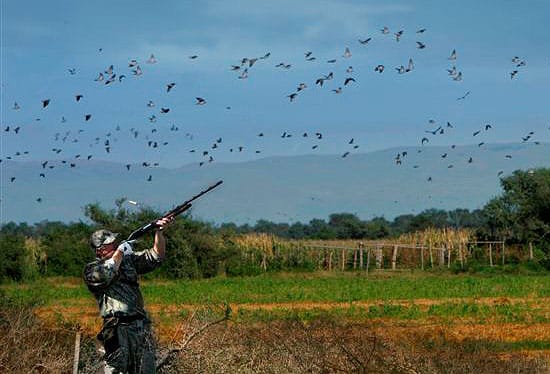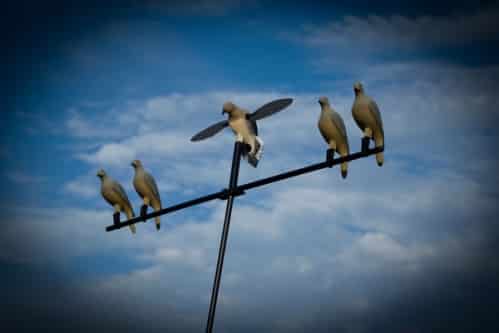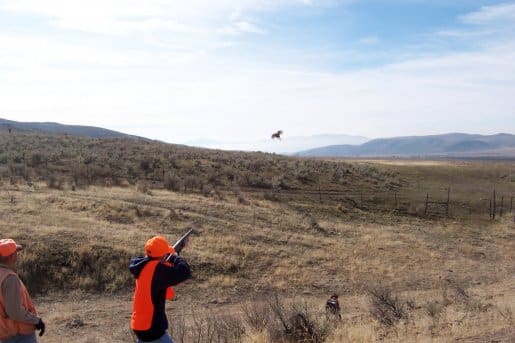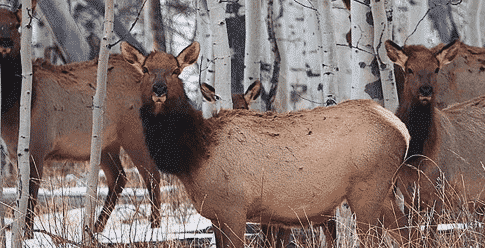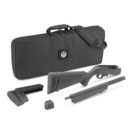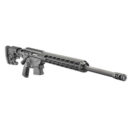Utah: What Hunters Should Know About the 2023 Upland Game Hunts
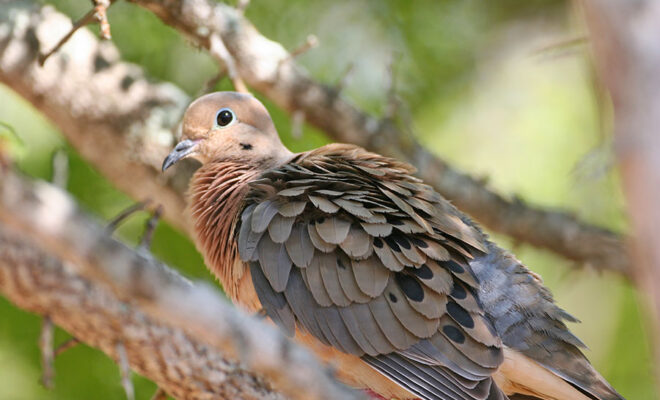
If you are wanting to try hunting for the first time or if you are a seasoned hunter looking for a new opportunity, upland game hunting is a great option! The majority of the upland game hunts in Utah are open to anyone with a Utah hunting license and don’t require an additional permit.
Utah offers a variety of upland game species, including doves, band-tailed pigeons, five different types of grouse, two types of partridge, cottontail rabbits and snowshoe hares. The Utah Upland Game Management Plan was approved last year to guide the management of upland game species in the state through 2032, and includes helpful resources including distribution maps for hunters.
Whether it’s a long-standing family tradition or you just want to try hunting a new species, here is a look at how Utah’s upland game populations are currently doing along with some tips that will help you during the hunts this fall.
Doves (mourning and white-winged)
Dove numbers have increased across much of Utah, due to the abundant snowfall last winter resulting in more water sources.
Mourning doves can often be found near agricultural grain fields (especially those with wheat and safflower) as well as areas with sunflowers because they provide a good food source for doves. Doves also need lots of water throughout the day, so hunting over water sources (including springs in sagebrush rangelands) and near feeding and roosting sites can help hunters find more doves.
If you want to hunt on private land, like on an agricultural field, you must obtain written permission from the landowner in advance.
White-winged doves are more rare in Utah, but can occasionally be found in the southwestern areas of the state. Hunters should also keep an eye out for white-winged doves in the same areas as mourning doves. Hunters may also see Eurasian collared-doves during their hunt. Collared-doves are not protected in Utah and can be hunted year round without a license or a bag limit. Collared-doves can also be found near agricultural areas.
“The weather in late August and early September can affect how many birds will be seen during the hunt,” Utah Division of Wildlife Resources Upland Game Coordinator Heather Talley said. “Doves tend to begin migrating south when nighttime temperatures drop into the 50s and as days get shorter, so hunters should plan to target them earlier in the season to increase their chances of success.”
Here’s what the dove numbers look like in each area of the state this year:
- Central Utah: The Tooele area offers some of the best mourning dove hunting in Utah, due to its many mountain ranges and vast expanses of public land. From data collected during DWR biologists’ surveys, dove numbers seem to be up this year in several areas of central Utah. Collared-doves can also be found in the Tooele area near agricultural fields.
- Northern Utah: There has been an increase in dove numbers in Box Elder, Davis and Rich counties this year, with a large number of doves on private land in eastern Box Elder County. The dove numbers in Cache and Weber counties appear similar to last year, with collared-doves outnumbering mourning doves in many of the valleys. Northern Utah has both mourning doves and collared-doves; however, since mourning doves migrate south for the winter, the best hunting opportunities for that species will occur early in the hunting season.
- Northeastern Utah: Mourning dove numbers seem to be up slightly this year in parts of northeastern Utah. When hunting doves, keep an eye out for collared-doves in this part of the state, as well.
- Southeastern Utah: DWR biologists found that dove numbers in the southeastern part of the state are improving and are slightly better than in recent years. Hunters tend to have the best success hunting early in the season and in areas near irrigated fields or where there is an abundant population of sunflowers.
- Southern Utah: Dove numbers have increased since last year in Iron, Beaver and Millard counties. However, their population numbers are still low in the Panguitch and Boulder Mountain areas. Hunters should be sure to target areas with food (agricultural fields and areas with sunflowers) and water sources to have success locating birds.
Because mourning and white-winged doves are migratory birds protected by federal law, you need a Harvest Information Program number to hunt them. Getting a HIP number is easy and only takes a few minutes. You can register for a free HIP number on the DWR website.
The hunting season for mourning and white-winged doves begins Sept. 1 and runs until Oct. 30. For more tips on hunting doves, visit the DWR website.
Band-tailed pigeons
While DWR biologists don’t do formal surveys for pigeons in Utah, the population has been relatively stable in recent years.
Look for band-tailed pigeons in southern Utah in areas with Gambel oak, aspen and conifers. However, Gambel oak acorn production has been low in many parts of the state, which is typically what pigeons rely on for food in the fall.
“Many Utah hunters don’t take the time to hunt band-tailed pigeons because they are a fairly secretive bird that is difficult to find,” Talley said. “However, they can be a unique challenge and an interesting new opportunity for hunters who are willing to put the time in to find them.”
Hunters should note that Eurasian collared-doves and band-tailed pigeons are often mistaken for one another. Eurasian collared-doves are primarily located in agricultural areas, while band-tailed pigeons are typically found in forested areas. Visit the Upland Game and Turkey 2023-24 Guidebook for more details about identifying each species.
Hunting band-tailed pigeons does require a permit, but the permit is free and available on the DWR website. You also need a HIP number to hunt band-tailed pigeons. You can register for a free HIP number on the DWR website.
The pigeon hunting season runs from Sept. 1-14.
Grouse (dusky and ruffed)
There are several grouse species throughout Utah:
- Dusky grouse (also known as the blue grouse, pine hen, pine grouse and fool hen)
- Ruffed grouse (also known as forest grouse and willow grouse)
- Greater sage-grouse
- Sharp-tailed grouse
- White-tailed ptarmigan
To hunt either greater sage-grouse or sharp-tailed grouse, you need a special permit in addition to a hunting license, and the application period for those permits ended July 19. However, you can still hunt dusky and ruffed grouse and white-tailed ptarmigan this fall with just a hunting or combination license.
The wet spring helped contribute to above-average spring hatches, resulting in an increase in grouse across most of Utah this year. Here are the population forecasts for each part of the state and where hunters should be able to locate dusky and ruffed grouse and ptarmigan:
- Central Utah: Dusky grouse can be found in the Oquirrh, Stansbury, Sheeprock, Deep Creek, Nebo and Manti mountains, and their numbers seem to be higher this year due to healthy spring hatches. DWR biologist surveys have also found that ruffed grouse numbers have increased this year in the Wasatch West area.
- Northern Utah: While heavy snowfall in northern Utah seems to have impacted winter survival rates and nesting behavior for sharp-tailed grouse and sage-grouse, hunters should expect to see similar or increased numbers of ruffed grouse in northern Utah this year as last year. Dusky grouse can be found in the Raft River Mountains. Ptarmigan can be found in high-elevation mountain areas in Summit County.
- Northeastern Utah: Sage-grouse numbers increased slightly this year in the northeastern part of the state, and ruffed grouse numbers look similar to last year. However, the grouse habitat is looking healthier due to this summer’s monsoon rains. Ptarmigan are also found in northeastern Utah in the Uinta Mountains, typically above the timberline. Heavy snowfall may have decreased their population numbers this year, but additional moisture will likely result in an increase of broods this year as well.
- Southern Utah: DWR biologist surveys have found that sage-grouse numbers are significantly increasing in the Boulder Mountain area; however, there are very few ruffed grouse in that area. Hunters can find dusky grouse in the Zion, Pine Valley and the southwest desert areas. The Beaver and Fillmore areas also both have healthy populations of dusky grouse. The number of ruffed grouse in the Monroe and Fishlake areas should be similar to last year. However, there are not many ruffed grouse in that area.
- Southeastern Utah: DWR biologists’ surveys found that brood production was good this year and above average throughout most of the southeastern part of the state. Brood size generally dictates hunter success for ruffed grouse. Hunters should expect hunting conditions to be better than the past two years.
Dusky grouse are about the size of a chicken and have drab brown and gray coloring. Their tail feathers are black except for the tips, which have a lighter gray color, and look like a wide band when the tail is fanned.
Ruffed grouse are gray and red and have a group of black feathers on the sides of their neck. Their tail feathers are the same color as their body, but have a dark black band near the end. Ruffed grouse can be found in stands of aspen, particularly young aspen. The aspen stands that also have shrubs with berries and a water source are the best places to spot a ruffed grouse. Hunters can also find ruffed grouse in mahogany patches.
For more tips on distinguishing between dusky and ruffed grouse, visit this Utah State University Extension link.
During fall and winter, grouse forage on the ground in areas where flowering plants (such as elderberry or serviceberry) or grains are available, and in areas dominated by thick sagebrush or in trees or shrubs with fruits and buds.
“Hunters who can locate the areas with the most berries should find good concentrations of grouse,” Talley said. “The birds migrate upslope as the season progresses and can be found in high-elevation conifer forest areas by early October.”
If you’re able to hunt with a dog, the best time to hunt grouse is an hour or two after sunrise, while the birds have been feeding, so that there will still be scent on the ground for your dog to track. If you hunt grouse without a dog, try early in the morning or late in the afternoon because that is when the birds are actively feeding and will be the most visible.
“People usually hunt grouse with dogs, but you will still want to move slowly and stop routinely to listen for birds. You may even be able to see them crouched down as you pass,” Talley said. “Sporadically stopping may cause the grouse to flush because they get nervous if you are close to them. And because grouse can escape quickly when they flush, be ready to shoulder your gun for a shot. Since grouse spend most of the day on the ground, you can still find them at any time during the day. This means you can still be successful if you are hunting without a dog between prime feeding times.”
Hunters should look for ptarmigan in areas with succulent green vegetation near water sources and in high-elevation willow patches, especially at the base of rocky slopes.
The dusky and ruffed grouse season runs from Sept. 1 to Dec. 31, and the ptarmigan season runs from Sept. 1 to Oct. 31. For more tips on hunting these species of grouse, visit the DWR website.
Partridge (chukar and gray)
Here’s what hunters should know about chukar hunting in each area of the state:
- Central Utah: Tooele County offers some of the best chukar hunting in Utah, with several populations in a variety of mountain ranges and lots of accessible public land. Rocky slopes west of I-15 contain the highest densities of birds. DWR biologist surveys show that the chukar numbers in the West Desert ranges and Manti and Nebo areas are above average this year.
- Northern Utah: There was a decrease in the number of adult chukars that survived the severe winter and heavy snowfall in several parts of northern Utah. However, the wet spring provided great breeding and nesting conditions, and spring hatches were above average in Box Elder County. Because of these conditions, hunters can expect a better hunting season than last year in that area. Hunters can also locate birds in the western part of Cache County and also on portions of the Bear River Mountain Range. Pen-reared birds are released each year before the hunt on the East Canyon and Henefer-Echo wildlife management areas. Check the DWR website to see where chukars will be released across northern Utah prior to the hunts.
- Northeastern Utah: This area of the state doesn’t typically have a lot of chukar partridge. Chukar numbers are up slightly from last year, but still below normal.
- Southern Utah: Hunters can typically find chukars in the mountain ranges in Washington, Beaver and Millard counties, including the Oak Creek, Crickets and House ranges. Chukars can also be located in the foothills along the west side of the Monroe Mountains and in the rocky slopes of Kingston Canyon. Check the DWR website to see where chukars will be released across southern Utah prior to the hunts.
- Southeastern Utah: Look for chukars in the cliff areas along the Price and Green rivers and near the face of the Book Cliffs. DWR biologist surveys show that brood production was above average for the second year in a row in the southeastern part of the state, and hunting should be better than the past several years.
Hunters should focus on steep slopes with rocks and bunch grass, sagebrush or cheatgrass, as well as areas with water. The best time to hunt chukars is early in the morning because that’s when they feed and tend to be vocal, making them the easiest to find.
“If one of the birds sees you while the rest are feeding, it will call out to alert the others, helping you locate the rest of the group,” Talley said. “You may increase your success rate hunting near water, but chukars aren’t completely dependent on water, and rely on it even less later in the year. Once winter hits, hunt the south-facing slopes, where the sun will be melting snow and warming the rocks, making it a good area for chukars.”
Gray partridge (also known as Hungarian partridge) are only found in northern Utah. DWR biologist surveys saw a decrease in adult survival rates in northern Utah, but an increase in the brood production this spring due to the wet conditions. Overall, hunters should expect to see fewer gray partridge this year, and can find them in the following areas:
- Northern Utah: Look for gray partridge in the western part of Box Elder County and on private land in eastern areas of the county, as well as in the Bear River Mountain Range and on private property in the western part of Cache County. Don’t forget to get written permission from the landowner before entering any private property.
Both partridge seasons will run from Sept. 30, 2023 to Feb. 15, 2024.
Cottontail rabbits
Cottontail rabbit population numbers are still at the low end of their population cycle throughout most of Utah, due to weather impacts and rabbit hemorrhagic disease serotype 2 (RHDV-2).
Look for these rabbits in creek bottoms and washes, near thick sagebrush and willow trees. Cottontail rabbits can also be found near rocky outcroppings. Hunters should also try hunting early in the morning or late in the afternoon when the rabbits are feeding.
Hunters should be able to find cottontail rabbits in the following areas:
- Central Utah: On the west side of the Manti area in brushy creek bottoms and throughout the Tooele area.
- Northern Utah: Throughout Rich County, but their numbers have decreased dramatically, likely due to the record snowfall last winter. They can also be found on private property in Morgan and Davis counties.
- Northeastern Utah: Some areas of northeastern Utah have pockets with decent numbers of rabbits, but overall, cottontail rabbit numbers are low in this part of the state.
- Southern Utah: On the Parker Mountain plateau, in areas with thick brush and washes. Overall, cottontail rabbit numbers seem to be increasing in southern Utah.
- Southeastern Utah: Throughout southeastern Utah, and DWR biologist surveys show that cottontail numbers are slowly increasing in this part of the state. Hunting should be slightly better in southeastern Utah than it was last year.
“Hunters also often have success finding cottontails in the transition areas between sagebrush and agriculture fields,” Talley said.
If multiple hunters walk in a straight line with several yards between them, they’re likely to find some rabbits feeding or resting. Be sure to walk slowly and quietly because cottontails have incredible hearing. Be sure to wear hunter orange, since it won’t deter the rabbits, and will make it easier for other hunters to spot you.
Small caliber rifles, such as .22 and .17, are great for rabbit hunting, or you can also use shotguns with No. 6 shot. Note that some areas require lead-free ammunition, so be sure to look up restrictions before you head into the field. Find more cottontail rabbit hunting tips on the DWR website.
Hunters should also note that rabbit hemorrhagic disease was confirmed in several wild rabbit populations in Utah in 2020. Specifically, it was found in cottontail rabbits in the Teasdale area of Wayne County, the Monticello area of San Juan County and in Uintah County.
“The good news is that, so far, it doesn’t look like rabbit hemorrhagic disease resulted in widespread, permanent losses of rabbits in any of these areas,” Talley said.
Infected wild rabbits may be lethargic and not flee when approached. If the rabbit you harvested seemed to act normally at the time of the hunt, it is unlikely that it has the disease. However, if you notice any discoloration or excessive bleeding on internal organs after harvesting the rabbit, or if you see anything that appears abnormal or causes concern, please contact your local DWR office and do not consume the rabbit, as a safety precaution.
The cottontail rabbit season runs from Sept. 1, 2023 to Feb. 28, 2024.
Snowshoe hares
Snowshoe hare populations are also low statewide. Hares can be found in high-elevation forest areas with conifer and aspen trees. The best habitat for hares is typically 8,000-9,000 feet in elevation and is more difficult to access than where cottontails are found.
Hunters should be able to find snowshoe hares in the following areas:
- Central Utah: In the Nebo, Wasatch, Tintic and Manti areas.
- Southern Utah: In the Tushar Mountains, the Monroe and Fish Lake areas and a small population in the Boulder Mountain area.
While they are a brownish-gray color in the summer, snowshoe hares are completely white in the winter, except for the black tips of their ears. The best strategy for finding hares is to wait for the first snowstorms of the year, and then look for the hare’s unique tracks. Their track looks like a miniature snowshoe, hence their name. Snowshoes or snowmobiles are often essential if you want to hunt snowshoe hares after the snow falls.
Snowshoe hares have a limited home range, so if you find an area that has plenty of tracks in it, there’s a good chance a hare is hunkered down in some vegetation nearby. Move slowly through their habitat, watching for the outline of a hare and its dark black eyes. Kicking brush piles as you walk can also cause hiding hares to flush into the open.
Small-caliber rifles and shotguns are great firearms to use for hunting hares.
The snowshoe hare season runs from Sept. 1, 2023 to March 15, 2024.
Upland Game Slam
To add an extra challenge to your hunts this fall, consider participating in the Upland Game Slam. The slam encourages hunters to harvest a variety of upland game species, while generating money to help fund a variety of habitat and upland game-related projects.
Hunters complete a slam by harvesting the required amount of the target species. There are currently eight different slams that hunters can participate in. Each one is designed to give you an extra challenge while you’re hunting, as well as the opportunity to earn a commemorative, collectible coin. The entry fee is $20 for hunters 18 years of age or older, or $10 for hunters 17 years of age or younger. Learn more about how to participate in the Upland Game Slam on the DWR website.
Check the 2023-24 Upland Game and Turkey Guidebook for details on regulations for hunting each species, including the legal weapons for each upland game species.
Youth hunts
The dates for this year’s upland game youth hunts are as follows:
- Chukar and gray partridge: Sept. 23-25
- Quail: Oct. 28-30
- Pheasant: Oct. 28-Nov. 2
The DWR and partners will also be holding several organized youth pheasant hunts in November in different areas of the state. Chukars and pheasants are released in areas across the state prior to their respective youth hunting seasons, as well as before the general hunting seasons. Visit the DWR website for more details about those upcoming events and for additional information about quail and pheasant hunting tips for this fall’s hunts.
- Mourning doves: https://drive.google.com/open?id=1xhYrDeNCGi3-VZT4Z_BWneM3f-n52yPF
- White-winged doves: https://drive.google.com/open?id=1wvlib5SWjXMwuRQ_XT_v9UIPnjsvYCDa
- Band-tailed pigeons: https://drive.google.com/open?id=1aGsIUn6e5xxOiBgeHtcsGh5-KFu2vi2j
- Dusky grouse: https://drive.google.com/open?id=1_6o1vuvK6_xXkMQdY6LpfBCD4eIjLWIs
- Ruffed grouse: https://drive.google.com/open?id=16Kz5bhhZF4oUx2Nd4XGvYgDUUds22x-a
- Ptarmigan: https://drive.google.com/drive/folders/1xYx2E5UifrOGNH5P7udrlIHMGVAsMDBp?usp=drive_link
- Chukar partridge: https://drive.google.com/open?id=1YwDdj-sjb8jMPmYCQgabl_YGQI96DKfV
- Gray partridge: https://drive.google.com/open?id=1ggQpdw_49ZyqQgRfbLJdgfOZ08DkDAKN
- Cottontail rabbits: https://drive.google.com/open?id=1cfoFl66rJnNGmJ_i5C1NVYrJE87mYlCK
- Snowshoe hares:
- https://drive.google.com/open?id=141gQIKmsYMmdE3c_HkSo1bKwg_HydCXY
Media contact: DWR Public Information Officer Faith Heaton Jolley at 385-266-2640

